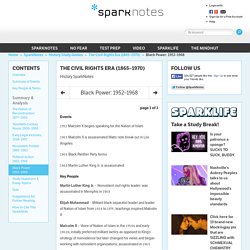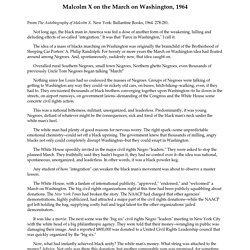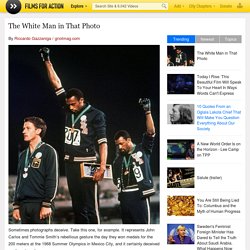

Thinking about IMPACT. READ ME I'M A GREAT WEBSITE! Civil Rights Movement: "Black Power" Era. The impressive March on Washington in the summer of 1963 has been remembered as one of the great successes of the Civil Rights Movement, a glorious high point in which a quarter of a million people—black and white—gathered at the nation's capital to demonstrate for "freedom now.

" But for many African Americans, especially those living in inner-city ghettos who discovered that nonviolent boycotts and sit-ins did little to alter their daily lives, the great march of 1963 marked only the first stage of a new, more radical phase of the Civil Rights Movement. You probably just finished reading the first chapter of the Civil Rights Movement. (Hint, hint.) Isn't it incredible how much had been accomplished by civil rights activists from World War II to the 1963 March on Washington? Isn't it staggering just how much had been sacrificed, how high the stakes had been raised, and how widespread the movement had become? Let's quickly review some highlights. How can this be? Not exactly. Timeline of events in Civil Rights movement. The U.S. Supreme Court ruled in the Dred Scott decision to deny citizenship and constitutional rights to all black people, legally establishing the race as "subordinate, inferior beings -- whether slave or freedmen.
" Emancipation Proclamation issued by President Lincoln freed slaves in the Confederacy. The 13th Amendment to the United States Constitution abolished slavery. However, Southern states managed to revive slavery era codes creating unattainable prerequisites for blacks to live, work or participate in society. DOUBLE CLICK ME! The influence of Black Power on the Civil Rights movement. Black Power - lots of good quotes on this site to use. “Black Power”, as a term, is most associated with Stokeley Carmichael, the 1960’s civil rights leader.

In fact, “Black Power” had been used as a civil rights rallying phrase by Willie Ricks, an SNCC man, before Carmichael used it on the “March Against Fear”. Black Power: 1952–1968 Events, people and impact. Events 1952 Malcolm X begins speaking for the Nation of Islam 1965 Malcolm X is assassinated Watts riots break out in Los Angeles 1966 Black Panther Party forms 1968 Martin Luther King Jr. is assassinated Key People Martin Luther King Jr. - Nonviolent civil rights leader; was assassinated in Memphis in 1968 Elijah Muhammad - Militant black separatist leader and leader of Nation of Islam from 1934 to 1975; teachings inspired Malcolm X Malcolm X - Voice of Nation of Islam in the 1950s and early 1960s; initially preferred militant tactics as opposed to King’s strategy of nonviolence but later changed his views and began working with nonviolent organizations; assassinated in 1965 Stokely Carmichael - SNCC leader who expelled white members in 1966 and called for independence, self-reliance, and black nationalism in 1967 book Black Power.

Malcolm X and Black Power. Malcolm X the 'farce' on Washington speech, 1964. Malcolm X on the March on Washington, 1964 From The Autobiography of Malcolm X.

New York: Ballantine Books, 1964. 278-281. Not long ago, the black man in America was fed a dose of another form of the weakening, lulling and deluding effects of so-called "integration. " It was that "Farce in Washington," I call it. The idea of a mass of blacks marching on Washington was originally the brainchild of the Brotherhood of Sleeping Car Porters' A.
Overalled rural Southern Negroes, small town Negroes, Northern ghetto Negroes, even thousands of previously Uncle Tom Negroes began talking "March! " Nothing since Joe Louis had so coalesced the masses of Negroes. This was a national bitterness; militant, unorganized, and leaderless. The White Man in That Photo. Sometimes photographs deceive.

Take this one, for example. It represents John Carlos and Tommie Smith’s rebellious gesture the day they won medals for the 200 meters at the 1968 Summer Olympics in Mexico City, and it certainly deceived me for a long time. 1968 Summer Olympics Black Power salute. 5. Black Power and Violence. Watts Riots 1965. Background: The Watts Riot, which raged for six days and resulted in more than forty million dollars worth of property damage, was both the largest and costliest urban rebellion of the Civil Rights era.

The riot spurred from an incident on August 11, 1965 when Marquette Frye, a young African American motorist, was pulled over and arrested by Lee W. Minikus, a white California Highway Patrolman, for suspicion of driving while intoxicated. As a crowd on onlookers gathered at the scene of Frye's arrest, strained tensions between police officers and the crowd erupted in a violent exchange. The outbreak of violence that followed Frye's arrest immediately touched off a large-scale riot centered in the commercial section of Watts, a deeply impoverished African American neighborhood in South Central Los Angeles. Archival Collections and Reference Resources. Watts Riot begins 11th August 1965. Also on this day Lead Story A group of federal prisoners classified as “most dangerous” arrives at Alcatraz Island, a 22-acre rocky outcrop situated 1.5 miles offshore in San Francisco Bay.

The convicts–the first civilian prisoners to be housed in the new high-security penitentiary–joined a few dozen military prisoners left over from the island’s days as... American Revolution On this day in 1718, Francois-Louis-Frederic Haldimand, who would help bring the United Empire Loyalists and Six Nations of Iroquois to safety in Canada following the American War for Independence, is born in Yverdon, Switzerland. Automotive.